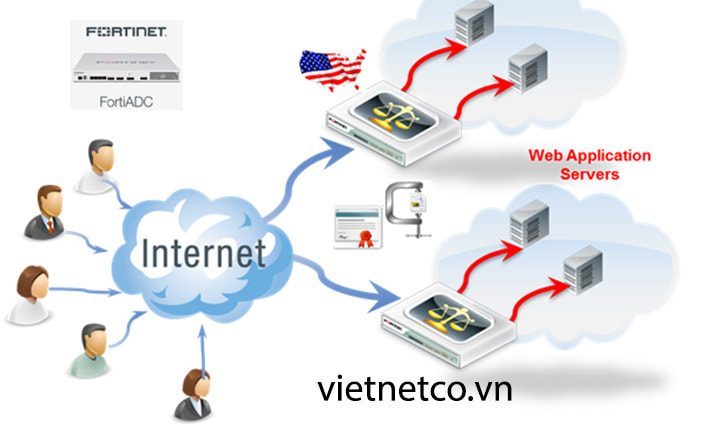Fortinet’s Application Delivery Controller (ADC) optimizes the availability, user experience, performance, and scalability of FortiADC’s Enterprise Application Delivery, family of physical and virtual devices providing acceleration Fast, secure and intelligent and deliver demanding enterprise applications.
Fortinet Application Delivery Controller allows you to reduce blind spots by implementing critical security controls in your virtual infrastructure. They also allow you to quickly deliver security infrastructure whenever and wherever it is needed. Furthermore, Fortigate virtual appliances have all the popular network and security services that are used in conjunction with traditional hardware-based Fortigate devices. With the addition of virtual appliances from Fortinet, you can deploy a mix of hardware and virtual appliances, work together and managed from a common centralized management platform.
1 / Fortinet load balancer (FortiADC)
Link Load Balancing (Link Load Balancing) features are designed to manage traffic across multiple internet service providers (ISP) or wide area network (WAN) links. This allows you to subscribe or provide multiple links, resulting in reduced risk of power outages, additional bandwidth for peak events, and potential cost savings if your ISP uses billing rates on bandwidth or peak / offpeak rate.
In most cases, you configure a link load balancer for outgoing traffic. Outbound traffic can be user or server traffic routed from your local network through ISC routing links, your subscriber line, or other WANs to those destinations. Internet or WAN. You configure binding policies to select entry for outgoing traffic.When the FortiADC system receives outgoing traffic that matches the source / destination / service identifier you configured, it switches Next it to an outbound gateway link following the system logic and policy rules you specify. The LLB feature supports load balancing between link groups or between virtual tunnel groups.
The Application Delivery Controller System evaluates the traffic to determine the routing rules to apply. For linked load balancing, the system will evaluate the rules in the following order and apply the first match:
a. LLB association policy
b. Policy route
c. Static / dynamic lines
d. LLB’s default association group
2 / GLOBAL LOADING BALANCE (GSLB)
Global load balancing (GLB) is a DNS-based solution that allows you to deploy redundant resources globally that you can leverage to keep your business online when deployed. Sudden local spikes or downtime occurred. The FortiADC system implements a hardened BIND 9 DNS server that can be deployed as an authoritative name server for the DNS zones you configure. Zone source records are dynamically generated based on a global load balancing framework.
The DNS response to the client request is an ordered list of responses that includes all available virtual servers. A client receives a DNS response with a list of first attempted responses and only proceeds with subsequent responses if the first answer is inaccessible. The response list is based on the following priorities:
a. Virtual Server Status – Availability is determined by real-time connectivity testing. When the DNS server receives a client request, it checks the connection for all possible combinations and excludes the unavailable servers from the response list.
b. Persistence – You can enable persistence for applications that have transactions on multiple servers. Combining table persistence has priority over proximity algorithms.
c. Geographical distance – The distance is determined by associating the source IP address with the FortiGuard Geo IP database or the Application Delivery Controller’s predefined Internet address book.
d. Dynamic slope – The distance is determined by the application response time (RTT probe) or least connected.
e. If the neighboring algorithms are not configured or applied, the existing virtual servers are listed in order based on the simple load balancing algorithm. The figure below shows an example of a global load balancing implementation with redundant resources at data centers in China and the United States.
With Fortinet’s complete Application Delivery Controller Provider solution at Viet Net (Application Delivery Controller Provider), it is convenient for businesses and companies to control the network status. Viet Net is proud to be the leading distributor of Fortinet. Please contact Viet Net for advice and participate in attractive promotions during this time via website www.vietnetco.vn/contact-us.html or hotline 1900 6736.
INFORMATION SOLUTION DISTRIBUTOR:


